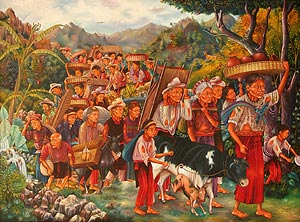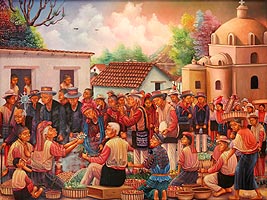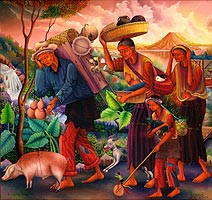| . | |
 |
|
| . | |
| . | |
| . | |
 |
|
| . | |
|
LINKS TO SECTION PAGES |
|
| . | |
| San Juan's first painter, Antonio Coché Mendoza, trained by Mariano González Chavajay, arose in 1985. Since then ten additional painters have appeared in San Juan. Outstanding among them is the first painter's cousin, Antonio Coché Ixtamer (b. 1968), a pupil of Pedro Rafael González Chavajay, who works as a bilingual instructor in San Juan's primary school. Pedro Rafael also teaches an art class one afternoon a week in San Juan for students in the third year of post-primary básico. Attending this art class ignited Ixtamer's interest in painting. | |
| . | |
 |
|
| . | |
| Around 1986 Antonio Coché Ixtamer began studying painting with Pedro Rafael on weekends. For six months Pedro Rafael had Ixtamer draw faces--faces and more faces--until his teacher was satisfied Antonio could draw well. Only then was he taught to mix colors, apply paint, and make simplified copies of paintings Pedro Rafael himself was working on. After studying with Pedro Rafael intermittently over the course of two years, Ixtamer began painting on his own, selling his canvases to galleries in Santiago Atitlán. They paid very little because they only wanted small quickly-produced pictures to sell to tourists. An American woman named Lianna Ward, who had started a women's weaving co-operative in San Juan, liked Ixtamer's paintings and showed his work to Jim Bell, an American who had a gallery in Antigua. Bell recognized Ixtamer's talent and began selling his paintings. In 1990, after having worked with Ixtamer for about a year, Bell suddenly grew ill and died. Discouraged by the loss of his patron, Ixtamer stopped painting. | |
| . | |
 |
|
| . | |
| In 1991, one of the author's of this article, Joseph Johnston, who had admired Ixtamer's paintings, arranged through Vicente Cumes, a San Pedro woodcarver, to meet Antonio Ixtamer and discuss his work. This expression of interest put Ixtamer back on track. He finished a canvas and walked to San Pedro to offer it to the owner of a gallery there, but Clemente Puzul, the owner, was not in. Disappointed, Ixtamer sat down on the stoop of a nearby house. By chance it happened to be the home of Vicente Cumes, who discovered the dejected Antonio on his doorstep and offered to buy the painting himself in order to encourage Ixtamer to continue working as an artist. This began an enduring relationship. An excellent sculptor himself, Cumes believes that certain of his ideas for artistic treatment can best be expressed by painters. He began acting as Antonio's mentor, suggesting themes and visiting Ixtamer in San Juan from time to time to advise him how to improve his depiction of people and other aspects of his paintings. Within a year, Ixtamer had produced several large paintings which established him as a leading artist. | |
| . | |
| LINKS TO SECTION PAGES |
|
|
To contact us write: Arte Maya Tz'utuhil, P.O. Box 40391, San
Francisco, CA 94140. Telephone: (415) 282-7654.
Email me at
All paintings and photographs Copyright © 1988–2015 Arte Maya Tz'utuhil |